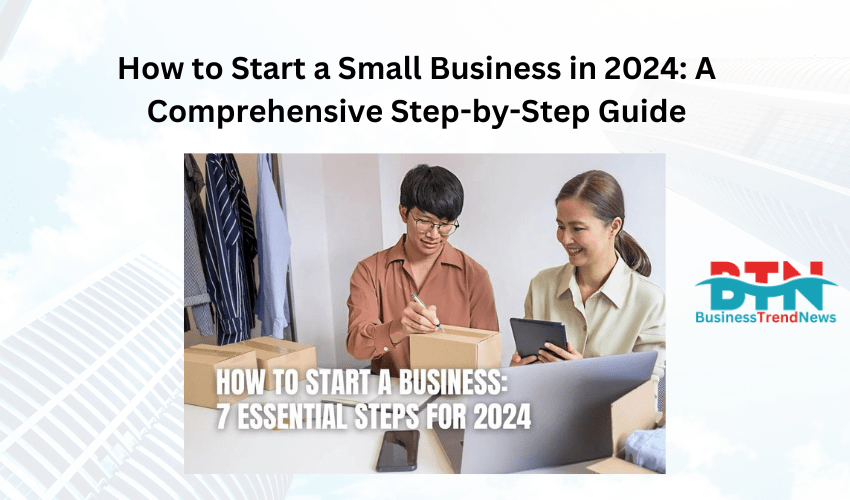![]()
How to Start a Small Business in 2024: A Comprehensive Step-by-Step Guide
Starting a small business is a thrilling and rewarding journey, but it can also feel overwhelming. Whether you’re looking to create an online store, open a local shop, or offer a unique service, the road to success requires careful planning, strategic execution, and perseverance.
In this detailed guide, we will break down the key steps to starting a small business in 2024, from the initial idea to launching and growing your venture. Whether you’re a first-time entrepreneur or looking to expand a side hustle, this guide will provide a roadmap for navigating the complexities of building a small business.
Step 1: Identify Your Business Idea
Choosing the Right Business for You
The first step in starting a small business is identifying a viable business idea. Your business should be aligned with your skills, passions, and the market demand. It’s important to assess not only your interests but also your unique value proposition: What problem are you solving, and how will your business stand out?
To begin:
- Assess Your Skills and Interests: Start by reflecting on your hobbies, skills, and experience. What do you enjoy doing, and what are you particularly good at? Whether it’s cooking, graphic design, or software development, your strengths should guide your business idea.
- Research Market Demand: It’s essential to ensure that there’s demand for your product or service. Use tools like Google Trends, online forums, and social media platforms to research what consumers are looking for in your industry. Additionally, check out competitors and see what’s already working.
- Consider Industry Trends: Emerging trends can provide opportunities for small businesses to carve out a niche. For example, sustainability, wellness, and tech innovations are growing sectors in 2024. A business that taps into current trends can gain traction faster.
Examples of Small Business Ideas:
- Online consulting services
- Handcrafted goods (e.g., jewelry, candles, home decor)
- Subscription box services
- Digital marketing or content creation
- Pet care services (e.g., grooming, walking)
- Local food trucks or catering services
Step 2: Create a Business Plan
Why You Need a Business Plan
A well-structured business plan is essential for guiding your business from concept to reality. It helps clarify your vision, outlines your goals, and provides a strategic roadmap for achieving success. Moreover, a business plan is crucial if you’re seeking investment or loans, as it demonstrates your business’s potential and direction.
Key Components of a Business Plan:
- Executive Summary: A brief overview of your business idea, objectives, and how you plan to achieve them.
- Business Description: Detailed information about your business, including the industry, target market, and the unique value you offer.
- Market Research: An analysis of the market you are entering, your target audience, competitors, and market trends.
- Organizational Structure: An outline of your business structure, including ownership and management roles.
- Products or Services: A description of your offerings, including pricing, development plans, and how they meet customer needs.
- Marketing Plan: How you plan to attract and retain customers, including your branding, sales strategy, and online marketing efforts.
- Financial Projections: Projected income, expenses, and cash flow over the next few years. This section should include startup costs and break-even analysis.
Step 3: Choose a Legal Structure and Register Your Business
Deciding on the Legal Structure
Your business’s legal structure will determine how much liability you have, how taxes are handled, and the complexity of your business setup. Here are the most common structures:
- Sole Proprietorship: The simplest structure, where the business is owned and operated by one person. This is common for small businesses but offers no liability protection—personal and business assets are one and the same.
- Partnership: If you’re starting the business with others, a partnership might be appropriate. There are two types: general (where partners share responsibilities equally) and limited (where some partners have limited liability).
- Limited Liability Company (LLC): An LLC offers the flexibility of a sole proprietorship or partnership with the liability protection of a corporation. This is one of the most popular choices for small businesses.
- Corporation: A more complex structure that offers the highest level of protection from personal liability but requires more formalities and costs. Corporations are typically better suited for larger businesses.
Registering Your Business
Once you’ve selected the structure, you’ll need to officially register your business. The process varies by country, state, and city, but generally includes the following steps:
- Choose Your Business Name: Select a unique, memorable name that reflects your business’s mission and offerings. Check for trademark availability and make sure the domain name is available if you plan to create a website.
- Register Your Business: Depending on your structure and location, you may need to register your business at the local, state, and federal levels. In the U.S., this can involve filing for an Employer Identification Number (EIN) with the IRS and registering with your state’s business department.
- Get the Necessary Licenses and Permits: Research the licenses and permits you’ll need to operate legally. These can include zoning permits, health department permits (for food businesses), and professional licenses.
Step 4: Secure Funding
Estimating Startup Costs
Starting a small business requires capital, whether you’re opening a brick-and-mortar store or launching an online business. Estimating your startup costs will help you determine how much funding you need. Common startup expenses include:
- Office space or leasing costs
- Equipment and supplies
- Marketing and advertising
- Website development
- Legal fees
- Initial inventory
Financing Options
There are several ways to finance your business. Choosing the right funding option will depend on your business model, your initial costs, and your growth plans.
- Bootstrapping: Many small businesses start with personal savings or funds from friends and family. Bootstrapping allows you to retain full control of your business but can limit your growth potential.
- Small Business Loans: Traditional bank loans or Small Business Administration (SBA) loans are common for businesses that need significant startup capital. You’ll need a solid business plan and good credit to qualify.
- Venture Capital and Angel Investors: If you’re launching a high-growth startup, you may attract investors in exchange for equity in your business. This is more common in tech or innovative sectors.
- Crowdfunding: Platforms like Kickstarter or GoFundMe allow entrepreneurs to raise funds directly from consumers in exchange for early products, rewards, or shares in the business.
Step 5: Build Your Brand
Developing Your Brand Identity
Your brand is the face of your business and is critical to establishing your identity in the market. A strong brand differentiates you from competitors and builds trust with customers.
- Name and Logo: Work with a graphic designer or branding expert to create a logo and name that reflect your business’s values and mission. Consistency is key, so use the same branding across all marketing materials.
- Color Scheme and Fonts: Choose colors and fonts that resonate with your target audience. For example, a business in the health and wellness industry might use calming, natural colors, while a tech startup might opt for sleek, modern design elements.
Creating a Website
In 2024, every small business needs an online presence. Whether you’re selling products online or promoting local services, a well-designed website helps customers find you and provides legitimacy.
- Domain Name: Choose a domain that matches your business name. This will help with brand recognition and search engine optimization (SEO).
- Website Builders: Platforms like WordPress, Shopify, and Wix make it easy for small business owners to create professional websites without coding experience. These tools offer templates and drag-and-drop features.
- SEO: Search engine optimization (SEO) is essential for driving organic traffic to your website. Optimize your site by using relevant keywords in your content, meta descriptions, and titles.
Step 6: Develop a Marketing Strategy
Reaching Your Target Audience
To attract customers, you’ll need a solid marketing strategy. This includes both online and offline tactics, depending on your business model.
- Social Media Marketing: Platforms like Instagram, Facebook, and TikTok are powerful tools for engaging with your audience. Use social media to share your brand’s story, showcase products, and interact with customers in real time.
- Content Marketing: Creating valuable content, such as blog posts, videos, or infographics, can establish your brand as an authority in your niche. This also boosts your website’s SEO ranking and helps drive traffic.
- Email Marketing: Collect customer emails and send regular newsletters or promotions to keep your audience engaged. Services like Mailchimp and Constant Contact make it easy to design and manage email campaigns.
- Paid Advertising: Pay-per-click (PPC) advertising on Google, Facebook, or Instagram can help you reach a larger audience quickly. PPC campaigns are highly targeted, allowing you to focus on specific demographics or customer behaviors.
Networking and Partnerships
Building relationships with other businesses and influencers can help your business grow. Attend industry events, join local business groups, and seek out collaboration opportunities to expand your network.
Step 7: Launch Your Business
Soft Launch vs. Full Launch
When your business is ready, decide between a soft launch or full launch. A soft launch involves releasing your products or services to a small group of customers before going public. This allows you to test your systems, gather feedback, and make adjustments.
A full launch involves announcing your business to the public through marketing campaigns, promotions, and events. Plan a launch day that builds excitement and drives traffic to your store or website.
Step 8: Monitor, Adjust, and Scale
Tracking Your Progress
Once your business is up and running, you’ll need to track performance and make adjustments. Use tools like Google Analytics, QuickBooks, and customer feedback surveys to monitor key metrics such as sales, website traffic, and customer satisfaction.
Scaling Your Business
As your business grows, you may need to expand your team, launch new products, or enter new markets. Stay agile, and be ready to adapt to new challenges and opportunities. By continually refining your business processes and staying focused on customer needs, your small business can achieve long-term success.
Conclusion
Starting a small business in 2024 is an exciting opportunity to turn your passions into profit. With the right planning, strategy, and persistence, you can navigate the challenges and enjoy the rewards of being your own boss. Follow these steps, stay adaptable, and watch your business thrive in the ever-evolving market.



